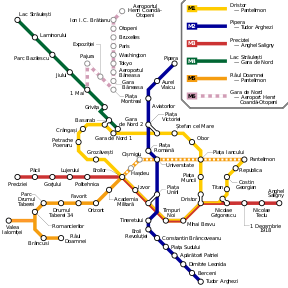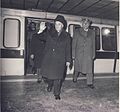Bucharest Metro
| Basic data | |
| Country | Romania |
|---|---|
| city | Bucharest |
| opening | November 16, 1979 |
| Lines | four |
| Route length | 71 km |
| Stations | 53 |
| Long-distance train stations | 1 |
| use | |
| Shortest cycle | 3-5 minutes |
| Passengers | 179.12 million |
| Employee | 4103 |
| vehicles | Astra, Bombardier, CAF |
| operator | Metrorex |
| Gauge | 1435 mm |
| Power system | 750 volts direct current , power rail , overhead line in the depot |
The Bucharest Metro , in Romanian Metrou Bucureşti , is the metro system in the Romanian capital Bucharest, opened in 1979, and the only one in the country. Today the responsible transport company is the public limited company SC Metrorex SA , but initially the metro was operated by the Romanian state railway Căile Ferate Române (CFR). In contrast , the municipal company Societate de Transport Bucureşti (STB) is responsible for surface transport, including the Bucharest tram and the Bucharest trolleybus . In 2016, 179.12 million passengers were carried.
Lines
The four Bucharest subway lines are 71 kilometers long, and together they serve 53 stations. The average station distance is 1.5 kilometers. There is a shuttle service (line M1) between Republica and Pantelimon stations . The Bucharest metro runs daily from 5:30 a.m. to 11:30 p.m. In the rush hour the other hand, runs every three to five minutes a train, in the remaining hours or on weekends every eight to 15 minutes. The shuttle service between Republica and Pantelimon is only offered during rush hour. The scheduled departure times are displayed with the help of stopwatches at the end of the platform, which show the time since the last train left.
| line | route | opening | length | Stations |
|---|---|---|---|---|
| M1 | Dristor - Republica (- Pantelimon) | 1979 | 31.7 km | 22nd |
| M2 | Pipera - Berceni | 1986 | 18.6 km | 14th |
| M3 | Preciziei - Anghel Saligny | 1983 | 17.6 km | 15th |
| M4 | Gara de Nord - Parc Bazilescu | 2000 | 6.1 km | 6th |
Tariff
The metro tickets are magnetic stripe cards and not valid for the RATB means of transport that use RFID chip cards. In contrast to surface traffic, where a new ticket is required every time you change, a subway ticket can be used for any length of time as long as the area within the platform barriers is not left.
Ceaușescu at the opening of the section in 1981
history
Construction of the first line began on September 20, 1975. It went into operation on November 16, 1979 between Timpuri Noi and Semănătoarea (today Petrache Poenaru), was 8.63 kilometers long and served a total of six stations. Today the M3 drives on this section, between Timpuri Noi and Eroilor also the M1. Unlike most of the subways in the other socialist states of the Council for Mutual Economic Aid (Comecon), Soviet vehicles were never used in Bucharest . The other sections went into operation as follows:
| opening | line | route | length | Stations |
|---|---|---|---|---|
| December 28, 1981 | M1 | Timpuri Noi - Republica | 10.1 km | 6th |
| August 19, 1983 | M1, today M3 | Eroilor - Industriilor (now Preciziei) | 8.63 km | initially 4, Gorjului opened later in 1991 |
| 22nd December 1984 | M1 | Semănătoarea (today Petrache Poenaru) - Crângași | 0.97 km | 1 |
| January 24, 1986 | M2 | Piața Unirii 2 - Depoul IMGB (today Berceni) | 9.96 km | 8th |
| October 25, 1987 | M2 | Piața Unirii 2 - Pipera | 8.72 km | 6th |
| December 25, 1987 | M1 | Crângași - Gara de Nord 1 | 2.83 km | initially 1, Basar opened in 1993 |
| 17th August 1989 | M3, now M1 | Gara de Nord 1 - Dristor 2 | 7.8 km | 6th |
| January 15, 1990 | M1 | Republica - Pantelimon | 1.43 km | 1 |
| March 1, 2000 | M4 | Gara de Nord 2 - 1 May | 3.6 km | 4th |
| November 19, 2008 | M3 | Nicolae Grigorescu 2 - Linia de Centură (now Anghel Saligny) | 4.75 km | 4th |
| July 1, 2011 | M4 | May 1 - Parc Bazilescu | 2.62 km | 2 |
| March 31, 2017 | M4 | Parc Bazilescu - Străuleşti | 1.9 km | 2 stations |
The M2 is connected to the M1 and thus the rest of the network with a single-track operating track.
Planning
The M4 line was extended on March 31, 2017 by the two stations Laminorului and Străulești . The associated Străulești depot, including the Park & Ride car park and bus terminals, is still under construction.
The start of construction for the new M5 line from Ghencea via Eroilor and Universitate to Pantelimon was in autumn 2011. Completion is to take place in stages; the opening of the Ghencea - Eroilor section with ten stations was planned for 2014 . But this was postponed.
There are also plans for an extension of the M4 line to the south of the city to the former Progresul station, for an M6 line to Bucharest Henri Coandă Airport and for an M7 line from the Rahova district in the southwest to the Colentina district in the northeast of Bucharest.
vehicles
There are three different types of metro in Bucharest:
- Astra multiple units (B'B'-B'B '), coupled together as a double multiple unit, 40 meters long, built between 1978 and 1993
- Bombardier railcar, 112.3 meters long, built from 1999
- CAF railcar, 114 meters long
The old Astra multiple units each have a driver's cab at the end of the vehicle and are therefore always coupled together as a double multiple unit. On the lines M1 and M3 (formerly also M2) three double railcars are always used together, on the M4, however, only two units. This type of vehicle was manufactured by Astra in Arad between 1978 and 1993 . Currently, depending on their age, these trains are either being replaced by the new Bombardier multiple units and taken out of service or refurbished for further operation. In 2008 there were 241 Astra double multiple units, of which 181 were used - the rest served as a reserve. This could create around 60 trains, the actual requirement was between 30 and 50 trains.
The Bombardier trains consist of six permanently coupled together cars, each with a cab at one end of the train and are completely accessible, similar to the Berlin underground Series H . In 1999 the operator Metrorex ordered the first 18 so-called Movia trains , in 2005 20 more followed for 110 million euros, in 2007 again six for 33 million euros; the European Investment Bank contributed to the costs. The car bodies made Bombardier in Görlitz , the bogies in Siegen produce drive technology needed again was in the Swedish town of Västerås made. The final assembly was done by a Romanian company.
The 24 CAF cars, which were purchased for € 145 million, have been used on the M2 line since July 2014.
In March 2015, CAF was able to win the follow-up tender for 51 trains for the new line 5 against the providers Astra Vagoane, Alstom, Pesa and CSR. The order has a volume of € 307.6 million. The vehicles are to be used on the underground line 5 Drumul Taberei - Eroilor, which is currently under construction.
The trains are either silver-gray with red or yellow stripes (Astra trains) or in stainless steel with black and white areas (Bombardier trains). The power is supplied with 750 volts direct current via a busbar mounted on the side and coated from below, as well as via a simple overhead line in the workshops and parking facilities. The maximum speed is 80 km / h, there are plans to increase it to 100 km / h in places.
Signaling
The signal system shows the same signal patterns as the CFR light signal system, but only combination signals are used ( main and distant signals are combined in a signal screen). The signaling system is designed for a headway time of 90 seconds. On the M2, the route signals have been replaced by the ATP system (driver's cab signaling), the route signals are darkened and only serve as a fall-back level, while the exit signals from the stations show “Halt” and the letters “ATP”. In the next few years, the other underground lines will also be converted to this system.
Web links
- Official operator website (Romanian and English)
- The Bucharest Metro at Urbanrail.net (English)
Individual evidence
- ↑ Raport de activitate 2016 , metrorex.ro p. 11
- ^ Tram atlas Romania 2004, page 50
- ↑ Raport de activitate 2016 , metrorex.ro p. 36
- ↑ Raport de activitate 2016 , metrorex.ro p. 2
- ↑ Pe cel mai nou tronson de metrou din Capitala before circula trenuri vechi de 40 de ani , stirileprotv.ro March 31, 2017
- ↑ Blickpunkt Tram , issue 2/2007, page 112
- ↑ Access from March 17, 2015: http://www.eurailpress.de/news/wirtschaft-unternehmen/single-view/news/rumaenien-caf-gewinnt-metroauf-bukarest.html
- ↑ http://www.railwaygazette.com/news/urban/single-view/view/caf-metro-trains-enter-service-in-bucuresti.html
- ↑ Access from March 17, 2015: http://www.eurailpress.de/news/wirtschaft-unternehmen/single-view/news/rumaenien-caf-gewinnt-metroauf-bukarest.html









